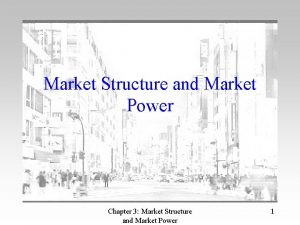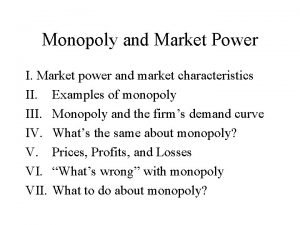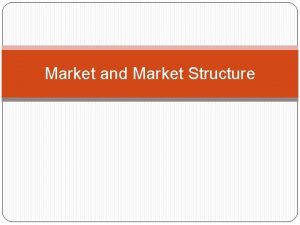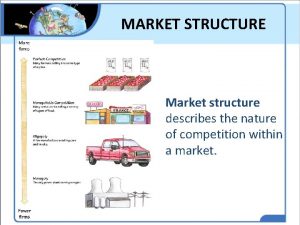Market Structure and Market Power Chapter 3 Market

















- Slides: 17

Market Structure and Market Power Chapter 3: Market Structure and Market Power 1

Introduction • Industries have very different structures – numbers and size distributions of firms • ready-to-eat breakfast cereals: high concentration • newspapers: low concentration • How best to measure market structure – – summary measure concentration curve is possible preference is for a single number concentration ratio or Herfindahl-Hirschman index Chapter 3: Market Structure and Market Power 2

Measure of concentration • Compare two different measures of concentration: Firm Rank Market Share (%) Squared Share 1 25 625 2 25 625 3 25 625 4 5 25 5 5 25 6 5 25 7 5 25 8 5 25 Concentration Index CR 4 = 80 Chapter 3: Market Structure and Market Power H = 2, 000 3

Concentration index is affected by, e. g. merger Firm Rank Market Share (%) 1 Assume that firms 2 4 and 5 decide to merge 3 25 4 5 5 6 7 } 25 625 Market shares 625 change 25 625 5 The Concentration Index changes 8 Concentration Index Squared Market Share } 10 25 25 CR 4 = 80 85 Chapter 3: Market Structure and Market Power H = 2, 000 } 100 2, 050 4

What is a market? • No clear consensus – the market for automobiles • should we include light trucks; pick-ups SUVs? – the market for soft drinks • what are the competitors for Coca Cola and Pepsi? – With whom do Mc. Donalds and Burger King compete? • Presumably define a market by closeness in substitutability of the commodities involved – how close is close? – how homogeneous do commodities have to be? • Does wood compete with plastic? Rayon with wool? Chapter 3: Market Structure and Market Power 5

Market definition 2 • Definition is important – without consistency concept of a market is meaningless – need indication of competitiveness of a market: affected by definition – public policy: decisions on mergers can turn on market definition • Staples/Office Depot merger rejected on market definition • Coca Cola expansion turned on market definition • Standard approach has some consistency – based upon industrial data – substitutability in production not consumption (ease of data collection) Chapter 3: Market Structure and Market Power 6

Market definition 3 • Government statistical sources – Fed. Stats – Naics • The measure of concentration varies across countries • Use of production-based statistics has limitations: – can put in different industries products that are in the same market • The international dimension is important – Boeing/Mc. Donnell-Douglas merger – relevant market for automobiles, oil, hairdressing Chapter 3: Market Structure and Market Power 7

Market definition 4 • Geography is important – barrier to entry if the product is expensive to transport – but customers can move • what is the relevant market for a beach resort or ski-slope? • Vertical relations between firms are important – – most firms make intermediate rather than final goods firm has to make a series of make-or-buy choices upstream and downstream production measures of concentration may assign firms at different stages to the same industry • do vertical relations affect underlying structure? Chapter 3: Market Structure and Market Power 8

Market definition 5 – Firms at different stages may also be assigned to different industries • bottlers of soft drinks: low concentration • suppliers of soft drinks: high concentration • the bottling sector is probably not competitive. • In sum: market definition poses real problems – existing methods represent a reasonable compromise Chapter 3: Market Structure and Market Power 9

The Role of Policy • Government can directly affect market structure – by limiting entry • taxi medallions in Boston and New York • airline regulation – through the patent system – by protecting competition e. g. through the Robinson. Patman Act Chapter 3: Market Structure and Market Power 10

Measuring Market Power/Performance • Market structure is often a guide to market performance • But this is not a perfect measure – can have near competitive prices even with “few” firms • Measure market performance using the Lerner Index P-MC LI = P Chapter 3: Market Structure and Market Power 11

Market Performance 2 • Perfect competition: LI = 0 since P = MC • Monopoly: LI = 1/h – inverse of elasticity of demand • With more than one but not “many” firms, the Lerner Index is more complicated: need to average. – suppose the goods are homogeneous so all firms sell at the same price LI = P-Ssi. MCi P Chapter 3: Market Structure and Market Power 12

Lerner Index: Limitations • LI has limitations – measurement: as with “measuring” a market – meaning: measures outcome but not necessarily performance – misspecification: • if there are sunk entry costs that need to be covered by positive price-cost margin • low price by a high-cost incumbent to protect its market Chapter 3: Market Structure and Market Power 13

Empirical Application: How Bad is Market Power Really? • Harberger (1954) exercise: Welfare Loss (WL) is: 1 WL = 2 (P – MC)(QC – Q) • Welfare Loss in relation to sales: WL = 1 (P – MC) (QC – Q) Q P 2 PQ • This can be expressed as: WL = 1 (LI)2 D PQ 2 Chapter 3: Market Structure and Market Power 14

How Bad is Market Power Really? 2 • Because most industries are not perfect monopolies, Harberger (1954) calculates WL = 1 (LI)2 D PQ 2 • For 73 manufacturing industries assuming D=1. Multiplying the result by each industry’s output and summing over all industries he estimates a total welfare loss from monopoly power of about two-tenths of one percent of gdp Chapter 3: Market Structure and Market Power 15

How Bad is Market Power Really? 3 • One problem is cost, possibly due to how advertising is 2 treated (P – MC) WL = 1 2 D PQ P • Under imperfect competition, MC may not be minimized, so P – MC may be artificially low. • Corrections by Cowling and Mueller (1978) and Aiginger and Pfaffermayr (1997) raise total cost substantially to between 4 and 11 percent of gdp Chapter 3: Market Structure and Market Power 16

Fast-Food Outlets Mc. Donald’s Burger King Wendy’s Chapter 3: Market Structure and Market Power 17
 Ac power formula
Ac power formula Example of negative externality
Example of negative externality Requirements for effective segmentation
Requirements for effective segmentation Solar power satellites and microwave power transmission
Solar power satellites and microwave power transmission Potential power
Potential power Dispersive power of grating is
Dispersive power of grating is Leader challenger
Leader challenger Capital structure in a perfect market
Capital structure in a perfect market Flex28024a
Flex28024a Power of a power property
Power of a power property General power rule
General power rule Power angle curve in power system stability
Power angle curve in power system stability Power bi training powerpoint
Power bi training powerpoint Power absorbed or supplied
Power absorbed or supplied @prof._jane_blendes:https://semawur.com/xujhhf16p
@prof._jane_blendes:https://semawur.com/xujhhf16p Deep and surface structure examples
Deep and surface structure examples S s' 's grammar
S s' 's grammar Static and dynamic queue in data structure
Static and dynamic queue in data structure

































